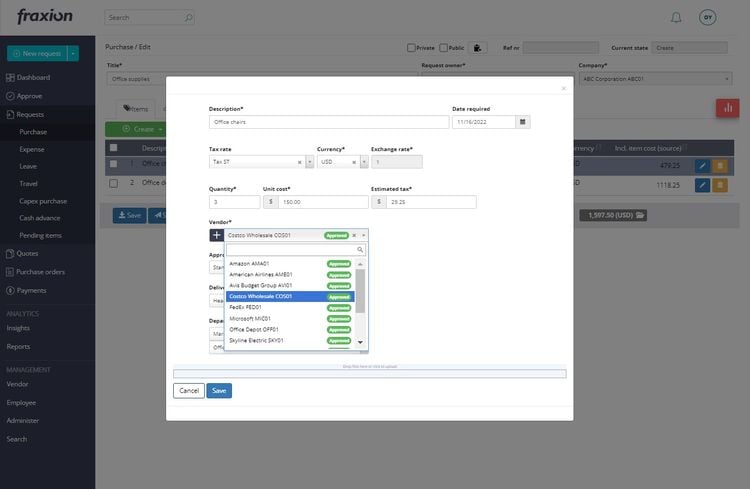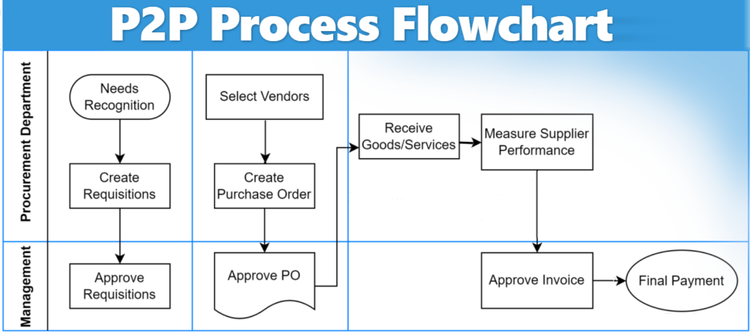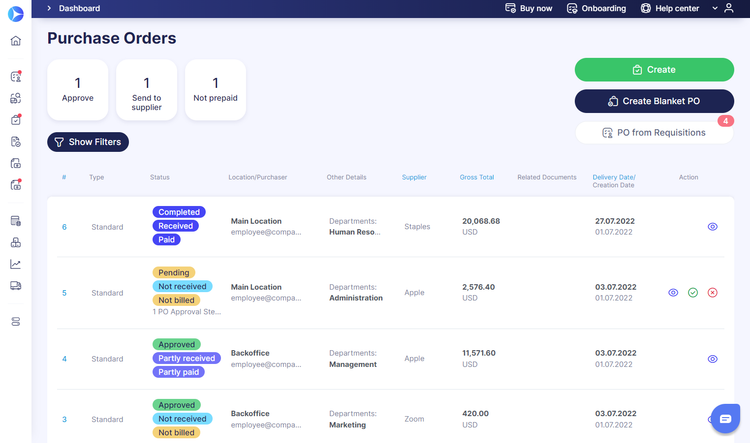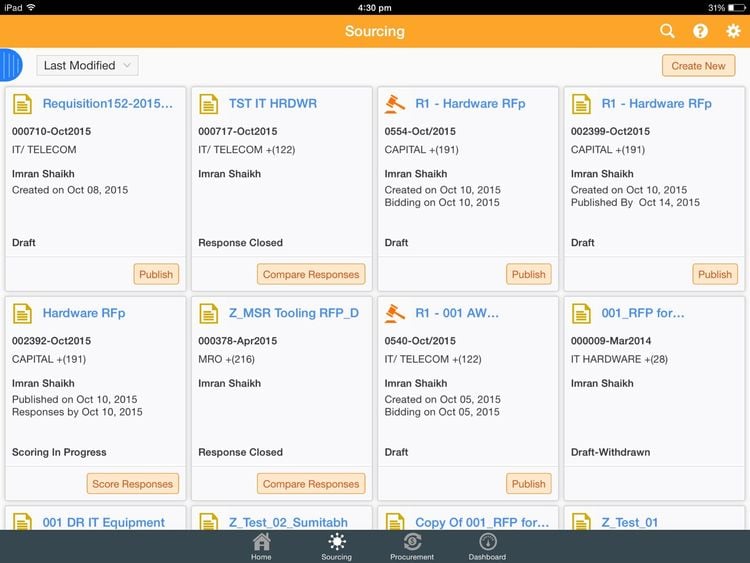Procurement vs. Sourcing: What’s the Difference?
Procurement is the process of acquiring goods and services, while sourcing is finding and qualifying the suppliers of those goods and services. While sourcing is a specific segment within the procurement process, and they work best collaboratively, they have some fundamental differences.
What is Procurement?
Procurement is the act of obtaining goods and services that a business needs to support its operations. Procurement gathers real-time information on the vendor, purchase quantities, items purchased, delivery timeframes, payment terms, and costs. This data is compiled into a purchase order–a financial document issued to suppliers when buying goods or services.
Procurement software ensures that each purchase order created is legitimate, authorized, and trackable. You can access real-time stock quantities, movement history, seasonal trends, and supplier lead times by linking with an organization’s inventory management system.

The procurement process starts by identifying a need. From there, a purchase requisition is created and sent to the procurement department. This purchase requisition is either approved or denied. If approved, the requisition becomes a purchase order sent to the appropriate vendor/supplier. When the goods or services are received, the supplier provides a receipt. This receipt is then sent to the purchasing department for an invoice matching the purchase or to complete the payment.
In short:
- Identify need
- Purchase requisition
- Approval
- Purchase order
- Goods/service receipt
- Invoice match/payment
Procure-to-Pay Process
There’s also the procure-to-pay process to consider. This focuses more on the transactional elements of procurement, from creating purchase requisitions to making payments to suppliers. There is even dedicated procure-to-pay software to help you automate transactions. The process goes as follows:

What is Sourcing?
Sourcing, sometimes referred to as strategic sourcing, is the process of developing supply chain channels at the lowest total cost. This includes all activities that revolve around identifying and assessing potential suppliers and selecting the appropriate supplier at the best possible cost.
Sourcing involves contract negotiations once an agreement has been reached between the buyer and supplier that outlines the terms of procurement. Usually, a company has sourcing professionals who evaluate the market and develop contractual agreements to ensure the company gets the best possible value.
The sourcing process starts with your procurement team defining the requirements of a new sourcing job. This job can be categorized based on the strategy your business is trying to implement (strategic sourcing). Knowing this information allows you to identify the correct supplier to whom you can submit an RFI or RFQ. The contract can be negotiated when a supplier has been identified and selected. Future supplier relationships are handled by managing these contracts for future cost savings in your overall supply chain management (officially known as “supplier management”).
In short:
- Requirements definition
- Category analysis/strategy
- Supplier identification
- RFI/RFQ
- Contract negotiation
- Contract management
- Supplier management
Key Differences
Sourcing and procurement both involve the work needed to operate your business. Proper vetting in the sourcing process can optimize the procurement strategy through improved automation and sustainability. Each step along the way in procurement directly impacts the step in the sourcing process. The primary differences include:
| Difference | Procurement | Sourcing |
|---|---|---|
| Focus | Focuses on the type of products and the entire purchasing process | Focuses on identifying, evaluating, and selecting suppliers. |
| Scope | More broad in scope, encompassing need identification to the final invoice | More specific in scope, as it focuses on supplier relationships and market research. |
| Supply Chain | Existing supply chains are used to purchase supplies for the business. | Builds and manages supply chains for purchases and helps get the best prices. |
How Sourcing and Procurement Work Together
While sourcing and procurement have distinct roles, they work best as a collaborative process that creates a continuous improvement cycle. Understanding their connection is crucial for optimizing your supply chain performance.
Where Sourcing Ends and Procurement Begins
The transition from sourcing to procurement typically occurs at contract finalization. Hand-off points are when the contract is signed, the supplier is added to your system, and performance baselines are established. From there, procurement teams are handed the day-to-day purchasing activities. But that’s not where the relationship ends.
The key is to create continuous feedback loops that allow procurement data to inform future sourcing decisions. Procurement helps give sourcing key insights into performance data, market insights, and improvement opportunities. Using that data, sourcing can work with underperforming suppliers, provide alternatives, and perform ongoing market analysis.
Collaborative Benefits
When the two processes are aligned, you can expect to see:
- Enhanced Supplier Relationships: Using both can help you gain feedback and create development programs for stronger, more strategic partnerships with your suppliers. This will benefit your day-to-day operations as well as your long-term planning.
- Cost Optimization: Procurement and sourcing data can both help each other identify cost-saving opportunities, whether through current suppliers or new ones in the market.
- Unified Reporting: Combined dashboards will lead to a more comprehensive analysis of your supply chain performance, with end-to-end metrics to support data-driven decision making.
- Faster Problem Resolution: When problems occur, joint sourcing-procurement teams can be faster to implement new solutions. These can be alternative suppliers, contract modifications, or operational adjustments.
Using Procurement Software
Procurement software allows you to issue orders for services and products by tracking all key order info in real-time, including the vendor, purchase quantities, item or service purchased, delivery timeframes, payment terms, and costs.
Also known as e-procurement or purchase order software, you can ensure each order is legitimate, authorized, and trackable. By linking your procurement solution to inventory control, you can access exact real-time stock quantities, movement history, seasonal trends, and supplier lead times.
Features of procurement software include:
- Purchase order document creation
- Vendor database
- Requisitions and approvals management
- Automatic or recurring orders
- Supplier lead time management
Critical supply chain benefits enabled by e-procurement software include:
- Improved cost control via authorizations and approvals to ensure the necessity and accuracy of individual purchases
- Reduced supply costs through improved capabilities to compare vendor options
- Increased customer satisfaction based on ensuring the timeliness of material provisioning
- Reduction in the administrative labor costs associated with purchasing activities through the use of software automation
Other benefits of procurement software include contract management, automation in the purchasing process, audit trails for improved accountability, and quicker meeting of customer demands.

Using Sourcing Software
While most procurement systems offer features intended for use in the sourcing process, strategic sourcing software will automate the process of gathering information needed to complete the purchasing process. This streamlines sourcing decisions in real time so you know when and where to get your needed goods and services.
The primary difference between sourcing software and procurement software is the focus on the data-gathering process to complete the procure-to-pay process. Most sourcing software will obtain bids and quotes from various vendors within a unified portal and compile the data into a single repository to compare figures side by side.
Similar to sourcing solutions, supplier relationship management software is a communication solution that organizes vendors as needed. It can be considered a CRM tool for suppliers, similar to an online Rolodex.

